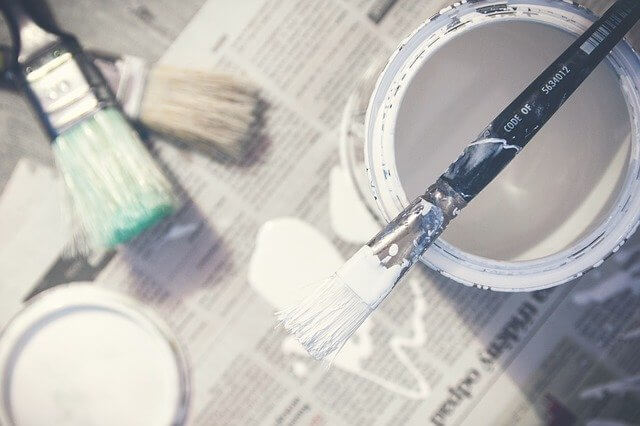
No two tenants are alike. While some may be very particular, others may not really care about property aesthetics at all. If you spend a while renting out your property, you’re sure to eventually wind up with tenants who want to have their say in the appearance of their unit.
Every tenant deserves a rental property that is clean and well-maintained, but there’s a difference between maintenance and decorating. Tenants may request quite a bit of freedom to make changes and redecorate the rental, which may include repainting the space.
So what should you do? Should you permit this or not?
When you’re trying to retain long-term tenants, how you handle a situation like this will be significant. You’ll likely want to contribute to the joy and happiness of your tenant by saying yes. On the other hand, you’ll likely feel hesitant about the unintentional damage. There are no shortage of issues that can emerge from an improper paint job.
Can you let tenant paint your property? Of course, it depends on your own preferences and taste as well. Are you very particular about the design and look of your units? This could make the decision to surrender a bit of control harder for you.
The landlord painting responsibilities of the rental property falls on the landlord. There are plenty of pros and cons of allowing or not allowing a tenant to paint your rental property. It all depends on your flexibility as a landlord. This article will present possible positive and the negative outcomes of tenants painting rental properties.
Pros of Allowing a Tenant to Paint the Unit
1. The Tenant Will Be Happy
It’s important in the rental property business to strive to keep tenants happy. Most landlords put a lot of effort into finding good tenants, but an equally important task is to hold onto good tenants once you have them.
While your main objective may be to keep your rental property vacancies at a minimum, it’s the renters themselves who can ensure that by sticking around. If you give a tenant flexibility in redecorating the unit and repainting it, you’ll provide feelings of freedom and happiness.
2.The Tenant May Be More Likely to Renew
If you allow the renter to redecorate or repaint your rental properties, they may be inspired to stay longer. They will likely feel an extension of ownership over the space, and will be happy to come home to the rental unit everyday.

It’s important for all of us to leave a mark of our individuality on their world. Making an impact on surroundings may make us more likely to want to stay where we are.
3. Encouraging a Sense of Home
With an opportunity to affect the aesthetics of their surroundings, renters may feel a sense of ease and comfort afterwards. After personalizing their home, renters will likely extend their lease agreement. After all, looking for other rentals takes considerable effort. It’s not every day that renters are permitted to make personal changes to reflect their own sensibilities.
Cons in Allowing a Tenant to Paint the Unit
1.Huge Time and Labor Allocation
If your tenant moves, repainting your rental property back to its original shade can be tiresome. Painting the interior of a unit can take up a huge amount of time, and it’s especially difficult to have maintenance done during a global pandemic.
For example, say you have a new prospect who wants to move in right away. They wouldn’t be able to do so if you needed to allot time for a repainting session to be done. If this new prospect was reliant on a speedy move-in, you could miss out on a reliable renter.
2. Maintenance Can Be Costly
Giving permission for tenants to paint the unit can have a great financial impact. If you want a professional job to be done, you’ll need to hire a professional painter. If the tenant plans to shoulder the expenses, it can be difficult to have control over the quality of the paint finish.

Your tenant might decide to perform the work on their own. The prospect of a poorly done job introduces a world of other potential stresses.
3. Possibility of a Huge Mess
Painting professionals exist for a reason. Painting properly is tough, and the mess of a bad paint job can affect the look of your rental property. There’s no shortage of potential problems that can arise after a substandard paint job. For just one example, a sub-par job could damage your flooring and furnishings and you will have to repaint walls.
Designing Detailed Conditions in the Agreement
Now that you’re aware of the pros and cons of permitting a tenant to repaint, are you still keen on giving the go-ahead signal? Or are you hesitant to acquiesce to the request? You can always choose a third option if you don’t want to respond with a definite yes or no.
Your third option would be to design detailed conditions in the lease agreements. You can permit the tenant to change the color of the rental property with provisions. This would limit the tenant’s control in redecorating the rental space, while also providing a sense of freedom at the same time.

Here are some questions to address in the leasing agreement:
- Should the tenant or landlord pay for the interior paint and its labor?
- Should the tenant repaint the unit back to the original shade upon moving out?
- What’s the required length of stay for the tenant to be permitted to alter the unit by repainting?
- Are there limits to a painting palette, or can the tenant choose any color they desire?
Being clear on your expectations and the landlord’s responsibility will greatly reduce any misunderstandings. The tenant’s task is to meet the conditions. As long as the tenant follows the agreement, there shouldn’t be any problems.
Making an Inventory
Since there will be changes to the appearance of your rental property, it’s advisable to make an inventory. This way, you can easily compare the past and present property conditions.
When you ask the tenant to revert the painting color back to the original upon the end of lease agreement, it will be quicker. Not having an inventory may result in stressful arguments. As much as possible, we aim for peace of mind as landlords.
Bottom Line
So, should you allow your tenants to paint your rental property? There’s no hard and fast rule to this. You can opt to make the renters happy, but then you’ll have to be ready for the drawbacks. After all, maybe you’ve had to have your unit painted already as one of the steps to get your unit ready for the rental market.
If you want to be more flexible but protect yourself at the same time, a good compromise solution is to give a conditional permission.
If you need professional property management to handle your property, contact Real Canadian Property Management Solutions at (780) 532-4900 or visit the website at www.rcpmsolutions.ca.